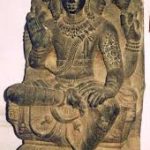 Prajapati was first a Vedic god (deva) of real importance, only to be reduced over the centuries to the function of a group (rank) of gods. Prajapati literally means the lord of creatures, of living beings. During the period of the Brahmanas he was the supreme being and father of the gods. He may have had his own cults. But his supremacy was taken over by Brahma, who was seen as creating Praja- pati to be his (Brahma’s) agent of creation. Later still, the myths tell of other Prajapatis also being created by Brahma to carry out all the aspects of creation. However, as Vishnu and Shiva rose to supremacy, Brahma came to be seen as their agent, subcontracting creation to first seven, then ten, and finally twenty-one or more Prajapatis, of whom Brahma was seen as one.
Prajapati was first a Vedic god (deva) of real importance, only to be reduced over the centuries to the function of a group (rank) of gods. Prajapati literally means the lord of creatures, of living beings. During the period of the Brahmanas he was the supreme being and father of the gods. He may have had his own cults. But his supremacy was taken over by Brahma, who was seen as creating Praja- pati to be his (Brahma’s) agent of creation. Later still, the myths tell of other Prajapatis also being created by Brahma to carry out all the aspects of creation. However, as Vishnu and Shiva rose to supremacy, Brahma came to be seen as their agent, subcontracting creation to first seven, then ten, and finally twenty-one or more Prajapatis, of whom Brahma was seen as one.
The twenty-one Prajapatis who created the rest of the world were Brahma, Rudra, Manu, Daksha, Bhrigu, Dharma, Tapa, Yama, Marici, Angiras, Atri, Pulastya, Pulaha, Kratu, Vasishtha, Parameshti, Surya, Chandra, Kardama, Krodha, and Vikrita.
Besides what was going on in theistic mythology with its personal creators, there was a philosophical school of thought that found the divine to be beyond name and form (nama-rupa) as an impersonal Absolute (Brahman), that “created” only in the sense that all phenomena were seen as a fundamentally unreal projection (maya) from the Absolute. This change in theology restructured cosmology and gave primacy to an asceticism of renunciation rather than an asceticism for powers and rewards.
However, the mythological viewpoint continued into the present. The Prajapatis or grandfathers continued as the re-creators after each destruction or partial destruction of the universe. Their continuing proliferation constituted Hindu mythology’s fundamental rejection of viewpoints that the cosmos is illusion.
See also Brahma; Brahman; Magic, Blessings, Cursing; Maya; chapter 2
For further reading:
